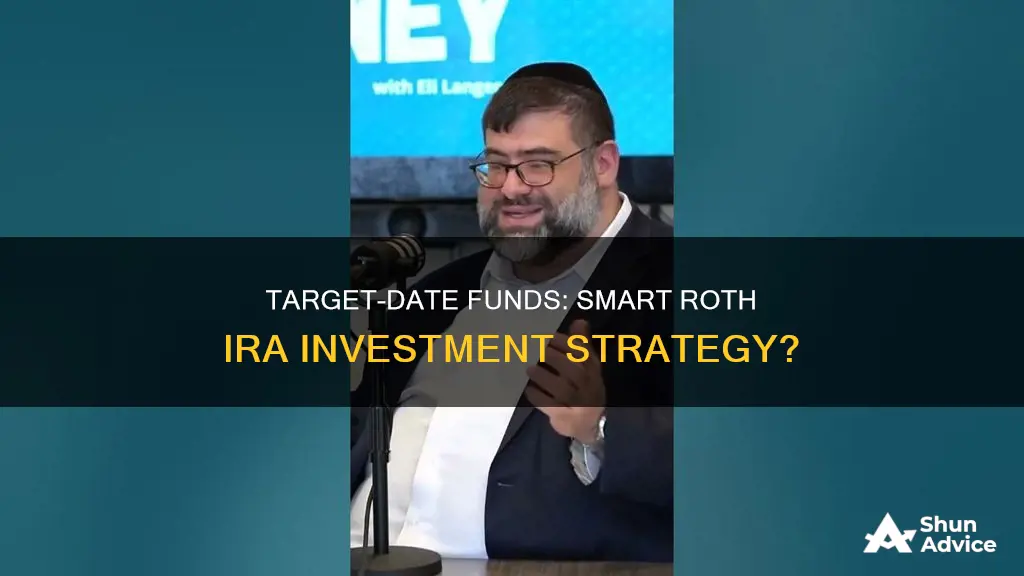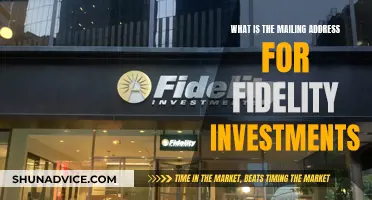
Target-date funds are a popular investment option for those saving for retirement. They are designed to help manage investment risk by automatically rebalancing an investor's portfolio from growth investments towards more conservative ones as retirement nears. The target date in a target-date fund is usually an investor's anticipated year of retirement. While target-date funds are a convenient, hands-off approach to investing for retirement, there are some potential drawbacks to consider. In this article, we will discuss the pros and cons of investing in target-date funds and explore whether they are a suitable option for a Roth IRA.
What You'll Learn

Pros and cons of target-date funds
Target-date funds are a popular choice for investors saving for retirement. They are designed to be the only investment vehicle that an investor uses to save for retirement. The concept is simple: pick a fund, put as much as you can into the fund, then forget about it until you reach retirement age. However, as with any investment, there are pros and cons to choosing a target-date fund.
Pros
- Simplicity: Target-date funds are simple to understand and invest in. They are a good option for investors who have no knowledge about investing and want a hands-off, passive investment.
- No rebalancing required: Target-date funds automatically rebalance your portfolio from growth investments toward more conservative ones as retirement nears, so you don't have to worry about rebalancing annually or changing holdings as you get older.
- Tinkering prevention: The all-in-one nature of target-date funds prevents excessive tinkering, which can drag on investor returns from excessive trading commissions and portfolio turnover.
- Low expense ratios: Target-date funds have low expense ratios compared to actively managed funds.
Cons
- One-size-fits-all: The generalized nature of target-date funds can leave investors exposed during unusual economic conditions. The one-size-fits-all approach may also keep your nest egg from reaching its full potential.
- Flawed assumptions: Target-date funds are based on the premise of static asset allocation, which assumes bonds are always less risky than stocks. This may not be the case in a period of rising inflation and higher interest rates.
- Lack of holistic view: Target-date funds use only one variable – a person's expected retirement date – to guide the construction of the portfolio. They do not consider an investor's holistic wealth circumstances, such as assets outside of the target-date fund (e.g. real estate, insurance policies, Social Security, etc.).
- Opaque fee structure: While most target-date funds have low expense ratios, some have less-than-transparent fee structures, with high fees in their underlying funds and very low or zero fees at the fund-of-fund level.
A Guide to Investing in Funding Societies
You may want to see also

How target-date funds work
Target-date funds are a “set it and forget it” investment option that removes the need for investors to decide on a mix of assets and rebalance those investments over time. They are designed to age with you by automatically rebalancing your portfolio from growth investments toward more conservative ones as you near retirement.
Target-date funds are mutual funds that purchase from other mutual funds to build a diverse portfolio. They are named according to their target retirement year, which is usually in five-year increments. For example, if you are 40 years old and plan to retire at 65, you would choose the provider's 2045 fund.
The funds' “glide path” refers to how they descend from a high ratio of riskier equity funds toward safer investments like bonds, and then land, freezing your asset allocation at its most conservative mix to protect your nest egg. For example, a fund may start with 90% of its investments in domestic and global equity funds, but by retirement, equity funds will make up only 30% of the total investment, with the remaining 70% consisting of fixed-income investments such as bonds and short-term funds.
Target-date funds are typically structured as a “fund of funds”, meaning they invest in other mutual funds rather than individual securities. They are a passive investment strategy, meaning they are not actively managed, and they are well-suited to investors who want to take a hands-off approach to their retirement.
Vanguard Energy Fund: A Smart Investment Strategy?
You may want to see also

Where to find target-date funds
Target-date funds are available from a range of financial institutions, including Vanguard, Fidelity, T. Rowe Price, Nuveen, and American Funds. Many company 401(k) plans offer target-date funds as an option, and they are also available for people investing in individual retirement accounts (IRAs).
Target-date funds are also known as life-cycle funds or target-retirement funds. They are a long-term investment account that is automatically adjusted over the years as the investor approaches retirement. They are designed to invest heavily in riskier growth stocks in the early years, and then lean towards more conservative choices in the later years.
Target-date funds are a common preset choice for a 401(k). If you have a 401(k) and never changed what's in it, there’s a good chance you already have a target-date fund. You can also open a brokerage account with a fund manager or online broker to shop for target-date funds. Or you can purchase one directly from a fund provider, but your choices may be more limited.
Mutual Funds in India: Invest Without a Broker
You may want to see also

Target-date funds vs. robo-advisors
Robo-advisors and target-date funds are both popular investment options for people who want a hands-off approach to building and managing their portfolios. However, they are designed for different situations and achieve that hands-off approach in different ways. Here is a detailed comparison of the two:
Fees and Costs
Robo-advisors typically charge a management fee that is a percentage of your invested assets. For example, robo-advisor Betterment charges $4 per month for accounts with balances under $20,000, while its fees go up to 0.25% of invested assets annually for accounts with balances of $20,000 or more. Additionally, the exchange-traded funds (ETFs) that robo-advisors invest in also charge an annual expense ratio. This means that investors who use robo-advisors pay fees to both the robo-advisor and the company that manages the fund.
On the other hand, target-date funds only charge an expense ratio, which is an annual fee expressed as a percentage of your investment. Investors do not pay an additional fee to a robo-advisor, making the cost of target-date funds often lower than robo-advisors. For example, Vanguard's Target Retirement 2060 fund (VTTSX) charges an expense ratio of 0.08%, which is lower than the 0.25% charged by Betterment.
Investment Strategies
Robo-advisors can invest towards a variety of goals, including retirement, producing income, and more. They typically use mutual funds or ETFs to construct portfolios. Robo-advisors offer more complex and flexible investment strategies and can personalize your portfolio based on factors such as your age, risk tolerance, and goals. They also have the ability to use more advanced investment strategies, such as tax-loss harvesting, to potentially increase returns.
Target-date funds, on the other hand, are specifically designed for retirement savings. They adjust their holdings over time to reduce volatility and risk as the target retirement date nears. These funds invest in more volatile assets with higher potential returns early on and then gradually decrease their stock holdings and increase their bond holdings as the target date approaches. This helps to reduce risk and volatility as investors near retirement age. While target-date funds can provide a diverse investment portfolio in a single fund, they are less personalized than robo-advisor portfolios.
Personalization
Robo-advisors excel in personalizing your portfolio. They use algorithms and take into account various factors, such as your age, financial situation, income, risk tolerance, and goals, to tailor their investment advice and portfolio construction. This makes them better suited for investors with varied financial situations and multiple financial goals.
Target-date funds, on the other hand, offer a one-size-fits-all approach. They are designed for a specific retirement goal and do not allow for customization of the underlying portfolio. While you can compare different funds from different management companies, the actual composition of the portfolio is not something you can adjust.
Minimum Investment Requirements
Investment minimums can vary for both robo-advisors and target-date funds. Robo-advisors like Betterment have no minimum balance requirement for most services, while others like Wealthfront have a $500 minimum balance. Target-date funds also have varying minimums, with some funds requiring as little as $1,000 or even less, while others may have higher minimums.
In conclusion, the choice between a robo-advisor and a target-date fund depends on your specific needs and situation. If you have a simple financial situation and are only saving for a specific long-term goal like retirement, a target-date fund could be a good choice due to its low costs and retirement focus. On the other hand, if you have varied financial goals, want a more personalized portfolio, or need to target multiple goals simultaneously, a robo-advisor may be a better option despite its higher fees.
Investing in HDFC Balanced Advantage Fund: A Comprehensive Guide
You may want to see also

Tips for choosing a target-date fund
Target-date funds are a popular choice for investors saving for retirement, but how do you choose the right one? Here are some tips for selecting a target-date fund:
- Pick your target date carefully: Choose a fund with a target year close to your planned retirement date. For example, if you are 30 years old and want to retire at 65, select a fund with a target date around 35 years in the future.
- Assess your risk tolerance: Compare funds with similar target dates and examine their investment strategies. Select the one that aligns with your risk tolerance, keeping in mind that your circumstances may change over time.
- Determine the fund's retirement approach: Read the fund's prospectus to understand if it is a "to retirement" or "through retirement" fund. "To retirement" funds reach their most conservative asset allocation on the target date, while "through retirement" funds continue to rebalance and reach their most conservative allocation after the target date.
- Monitor the glide path: Periodically review the investments of your target-date fund to ensure the investment manager has not changed the way the fund reallocates assets over time. Ensure the glide path remains consistent with your retirement strategy and risk tolerance.
- Understand automatic enrolment: If your employer has automatically enrolled you in a target-date fund, take the time to understand the fund. Evaluate if it aligns with your retirement savings needs, as you may find a different option better suited to your goals.
The S&P 500 Index Fund: A Smart Investment Move?
You may want to see also
Frequently asked questions
A target-date fund is an investment fund that automatically adjusts the risk level of your investments as you near your retirement age. The fund's portfolio is made up of a combination of stocks and bonds, with the mix becoming more conservative over time to protect your savings.
Target-date funds offer a "set it and forget it" approach to retirement savings. They are simple to use, as you only need to know your desired retirement age to get started. The funds automatically rebalance and adjust your holdings over time, removing the need for active management.
Target-date funds use a one-size-fits-all strategy, which may not be suitable for everyone. They may become too conservative too early, limiting the potential for growth. Additionally, the fee structures can be complicated, and you may need to pay higher fees compared to other investment options.







